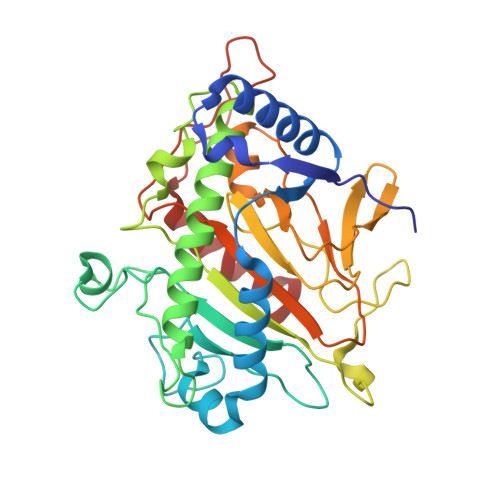The Reaction Cycle of Isopenicillin N Synthase Observed by X-Ray Diffraction.
Burzlaff, N.I., Rutledge, P.J., Clifton, I.J., Hensgens, C.M.H., Pickford, M., Adlington, R.M., Roach, P.L., Baldwin, J.E.(1999) Nature 401: 721
- PubMed: 10537113
- DOI: https://doi.org/10.1038/44400
- Primary Citation of Related Structures:
1QIQ, 1QJE, 1QJF - PubMed Abstract:
Isopenicillin N synthase (IPNS), a non-haem iron-dependent oxidase, catalyses the biosynthesis of isopenicillin N (IPN), the precursor of all penicillins and cephalosporins. The key steps in this reaction are the two iron-dioxygen-mediated ring closures of the tripeptide delta-(L-alpha-aminoadipoyl)-L-cysteinyl-D-valine (ACV). It has been proposed that the four-membered beta-lactam ring forms initially, associated with a highly oxidized iron(iv)-oxo (ferryl) moiety, which subsequently mediates closure of the five-membered thiazolidine ring. Here we describe observation of the IPNS reaction in crystals by X-ray crystallography. IPNS Fe2+ substrate crystals were grown anaerobically, exposed to high pressures of oxygen to promote reaction and frozen, and their structures were elucidated by X-ray diffraction. Using the natural substrate ACV, this resulted in the IPNS x Fe2+ x IPN product complex. With the substrate analogue, delta-(L-alpha-aminoadipoyl)-L-cysteinyl-L-S-methylcysteine (ACmC) in the crystal, the reaction cycle was interrupted at the monocyclic stage. These mono- and bicyclic structures support our hypothesis of a two-stage reaction sequence leading to penicillin. Furthermore, the formation of a monocyclic sulphoxide product from ACmC is most simply explained by the interception of a high-valency iron-oxo species.
Organizational Affiliation:
The Dyson Perrins Laboratory and the Oxford Centre for Molecular Sciences, University of Oxford, UK.

















